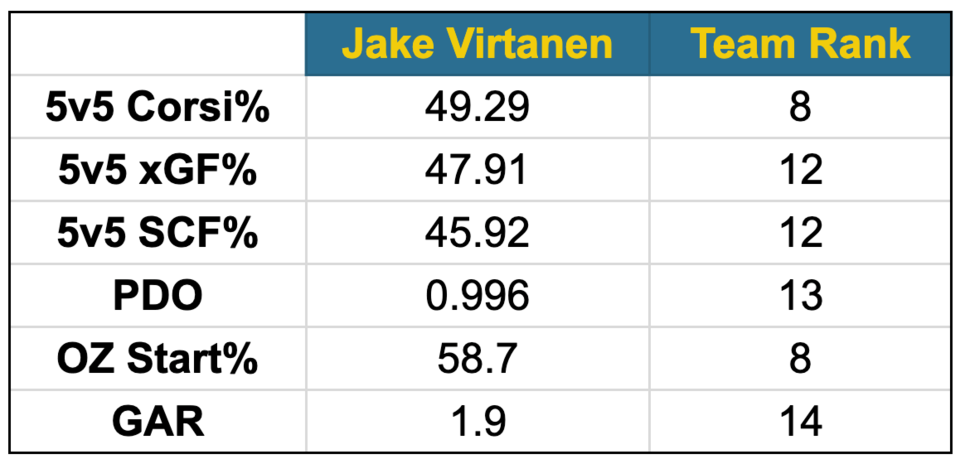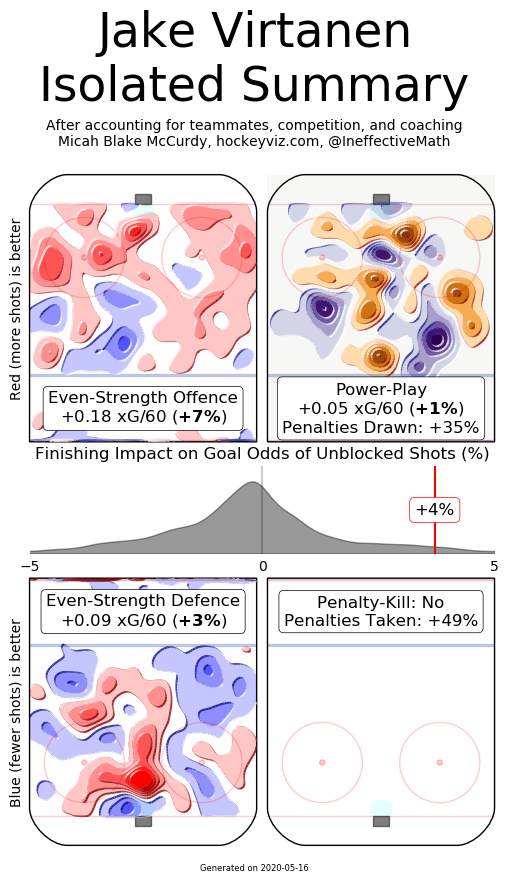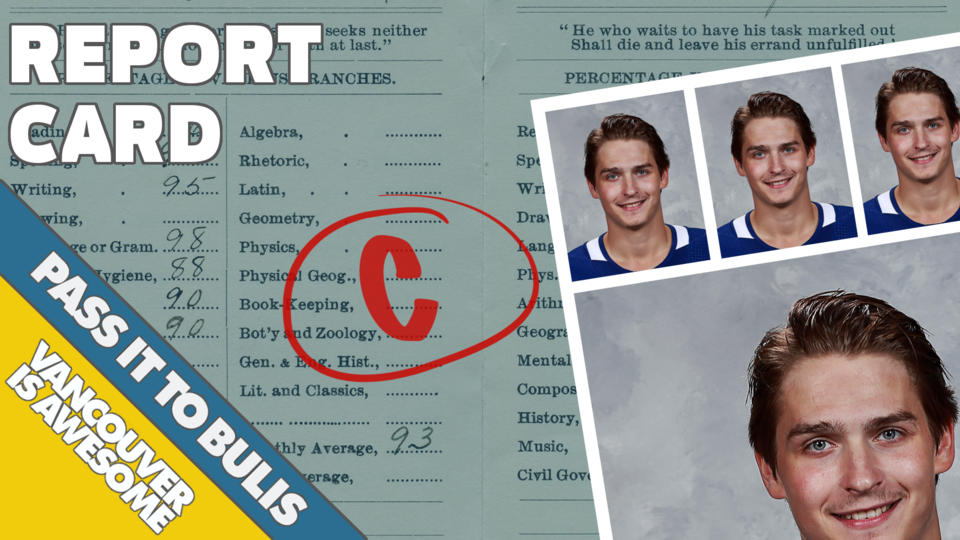Who is Jake Virtanen? Is he a late-blooming power forward just waiting for his chance to break out? Is he an opportunistic scorer with defensive deficiencies? Is he a top-six forward or a healthy scratch?
It seems like even Virtanen doesn’t know. At times the size, speed, and shot that allowed him to run roughshod over his junior competition shows up in the NHL, allowing him to burn up the ice, speed past a defenceman, and rip a shot past a goaltender.
At other times, Virtanen completely disappears.
It makes it hard to know what to expect from Virtanen next season. With few other options, he has a clear opportunity to take hold of a top-six spot in the lineup, possibly even on the first line with Elias Pettersson and J.T. Miller. The question is whether he can bring the consistency needed to regularly play in the top-six.
That’s something that has been on Virtanen’s mind as he’s trained with Tyler Myers in Kelowna during the offseason.
"I'd love to play top-six and have a bigger opportunity, more responsibilities," he said after re-signing with the Canucks. "I want to be able to prove that to the team and my teammates that I can play up there and be consistent every night."
He specifically talked about getting the details and little things right and becoming a more responsible player that can be used in more situations. If he can improve on his play away from the puck and become a more reliable contributor to the team’s success even when he’s not scoring, that will go a long way towards earning him top-six minutes all season long.
It’s one thing to talk about doing the little things right; it’s quite another to actually do it. Before we see whether Virtanen can take a step forward next season, however, we need to look back at where he’s stepping from by breaking down last season in his report card.
Math (Boxcar Numbers): B
Virtanen hit a new career-high in points, matching his jersey number with 18 goals and 18 assists. That was good enough for sixth among Canucks forwards in points. His 12 even-strength goals was good for fourth on the team and his 6 power play goals were likewise fourth.
The shortened season didn’t do him any favours, as he was likely to crack the 20-goal barrier, even if he’d hit a cold streak and hadn’t scored a goal in 7 games. He was on-pace for 21 goals and 42 points — solid second-line production.
The same can’t be said for his playoff performance. While he had a big goal in Game 6 against the Golden Knights to help take the Canucks to Game 7, he managed just three points in 16 games in the playoffs. That’s cause for concern.
Perhaps part of the issue is a lack of ice time. He averaged 13:05 per game in the regular season, 9th among Canucks forwards and behind Tyler Motte and Brandon Sutter. During the playoffs, he was a healthy scratch for the first game and his ice time dropped to 11:16 per game, 11th among Canucks forwards.
There’s an argument to be made that Virtanen could have produced more points with more ice time, but head coach Travis Green wasn’t comfortable with giving him more ice time. It might have to do with his minus-4 plus/minus in the regular season, though that’s not a very reliable statistic.
Considering his 20-goal pace and second-line production during the regular season, I’m giving Virtanen a solid B in Math. I’ll let the playoffs go, since they were played under extraordinary circumstances.
Science (Fancy Stats): C
What’s intriguing about Virtanen’s underlying statistics is that there’s a wide variance between how different models and hockey analytics view his performance last season. Let’s look at some numbers drawn from Natural Stat Trick http://www.naturalstattrick.com/ and Evolving Hockey. https://evolving-hockey.com/
 Jake Virtanen's 2019-20 fancy stats via NaturalStatTrick.com and Evolving-Hockey.com.
Jake Virtanen's 2019-20 fancy stats via NaturalStatTrick.com and Evolving-Hockey.com.Virtanen was below 50% in corsi, which is shot attempts for and against at 5-on-5. That by itself isn’t surprising — most of the Canucks were below 50% — and Virtanen was 8th on the Canucks and 6th among forwards.
When we start looking beyond just shot attempts, Virtanen’s numbers start to drop. Expected goals (xGF) measures the probability of each shot becoming a goal based on elements like shot location and shot type, while scoring chances (SCF) is what it sounds like. Virtanen’s xGF% and SCF% are below his corsi, which means the Canucks’ shot attempts when Virtanen is on the ice are not as dangerous or the opponent’s are more dangerous or both.
In Virtanen’s case, it’s largely driven by his defensive performance. Only three Canucks were on the ice for a higher rate of scoring chances against than Virtanen: fourth-liners Tyler Motte and Jay Beagle, and Tanner Pearson, who was used in a matchup role with Bo Horvat.
Unlike the fourth line, which started the majority of their shifts in the defensive zone, or Pearson and Horvat’s matchup role, Virtanen was relatively sheltered. He played against top lines less than the league average and started more of his shifts in the offensive zone than in the defensive zone. Thus, his defensive results can’t be excused by his usage.
That shows up in his Goals Above Replacement (GAR). While Virtanen was certainly better than a replacement-level player last season, he was dragged down by his defensive performance at even-strength. That took away from his positive offensive performance at even-strength and on the power play, as well as his impact in drawing penalties: he tied with Elias Pettersson for most penalties drawn with 17.
Micah Blake McCurdy’s model, on the other hand, is more favourable towards Virtanen, but we can see why when we look at his Isolated Impact heat map from HockeyViz.com.
 Virtanen's isolated summary from HockeyViz.com.
Virtanen's isolated summary from HockeyViz.com.These heat maps aim to isolate the contributions of an individual player by taking into account context such as quality of teammates and competition, zone starts, and coaching.
Virtanen’s offensive impact is quite good, at 7% above league average. It’s interesting to see where that impact comes from: an above-average number of shots from the slot, but also a large portion of shots from the sideboards, a reflection of his love for shots from bad angles.
On the defensive end, Virtanen allows more shots than average — 3% more dangerous than average. Almost all of that impact comes in the slot, however, and up through the hashmarks.
Perhaps the difference is that McCurdy’s model has a more positive view of those shots from the sideboards than other models. Those shots certainly wouldn’t register as scoring chances and would likely be of limited value for most expected goals models.
Virtanen is illustrative that “analytics” are not a monolith in hockey. It’s not as simple as saying, “This number means this player is good/bad.” There’s room for a lot of disagreement, discussion, and interpretation.
In my interpretation, those defensive numbers — particularly the high rate of scoring chances against despite sheltered minutes — are concerning and undercut a lot of Virtanen’s offensive impact. That’s clearly the area where he needs the most improvement, so I’m giving Virtanen a C.
Social Studies (Leadership and Intangibles): D
Hoo boy. This is where Virtanen doesn’t grade out quite as well.
I don’t want to be too harsh here, but there’s a reason why Virtanen’s conditioning seems to be in question heading into every training camp — two of them this past season! Couple that with some inconsistency in effort on the ice and you have one of the primary frustrations when it comes to Virtanen: plenty of tools, but not always the hard work to make best use of those tools.
Couple that with some questionable off-ice decisions and Virtanen’s intangibles take a hit.
As for leadership, the Canucks have expressed that they want him to step forward and become more of a leader, but he’s not there yet. An organization I worked with once described the first step towards becoming a leader of others is learning how to lead yourself. That’s where Virtanen is: he has to learn to self-motivate and lead himself before he can take a leadership role with the rest of the team.
Until then, Virtanen gets a D in this category.
Language Arts (Communication): C-
Communication is a mixed bag for Virtanen. I’ve had some excellent interviews with him in the past — he provided some fun quotes this last season for my article on the Canucks’ best and worst signatures — but he has a reputation for disappearing from the room after practices and games to avoid media scrums.
While some players always make themselves available to answer questions, win or lose, Virtanen does not. To a certain extent, I get it — I wouldn’t want to talk to me every day either — but it can be frustrating and it limits how often his voice and his words are seen and heard by Canucks fans.
Virtanen does communicate directly with fans on social media, mostly on his Instagram, but also on Twitter. His social media sometimes lands him in hot water, however, such as when he posted a video to his Instagram stories of him driving to practice in his hockey gear. Using your phone while driving is illegal, so it wasn’t the best decision to post a video of himself breaking that law.
Honestly, Virtanen has the potential to do well in this category. He has the ability to have fun with interviews and give quotes that break out of the usual hockey clichés. For now, he gets a C-.
Physical Education: A+
Virtanen is an elite athlete playing in the NHL.
Electives (Special Teams): A-
Virtanen became a consistent presence on the second power play unit in mid-December and made good use of his time on the power play when he did get the chance. In fact, Virtanen was the Canucks’ most efficient power play scorer, leading the team in both power play goals and points per hour.
While Virtanen’s 6 power play goals were fourth on the Canucks, they came in about a quarter of the ice time of the three players in front of him, Bo Horvat, J.T. Miller, and Elias Pettersson.
Virtanen and Adam Gaudette made the second power play unit work and gave it a very different feel from the first unit. The second unit had, as Canucks colour commentator John Garrett put it, a “shoot-first mentality,” throwing the puck on net at every opportunity, often shortly after entering the offensive zone.
That approach worked well for them, particularly in the more limited ice time the second unit received. They didn’t have as much time to set up in the offensive zone and create an ideal scoring chance, so trying to put the penalty kill on its heels with speed entering the zone and getting the puck to the net was the right strategy.
Virtanen’s success on the second unit doesn’t mean he’d have the same success on the first unit — he’d get fewer shots on a unit with the likes of Pettersson, Horvat, and Brock Boeser — but he was still a key part of the Canuucks’ power play success last season.
Overall: C
There were some significant positives in Virtanen’s season, as he provided some much-needed secondary scoring and helped drive the success of the second power play unit. The issue is that he undid a lot of those positives with his lapses in the defensive zone and couldn’t play consistently enough to earn a bigger role.
Still, there’s a foundation to build from. If Virtanen can come into training camp in better shape and show that he’s taken his coach’s desire for the details seriously, he has the offensive upside to have an impact in a top-six role. At this point, it’s all in Virtanen’s hands.




